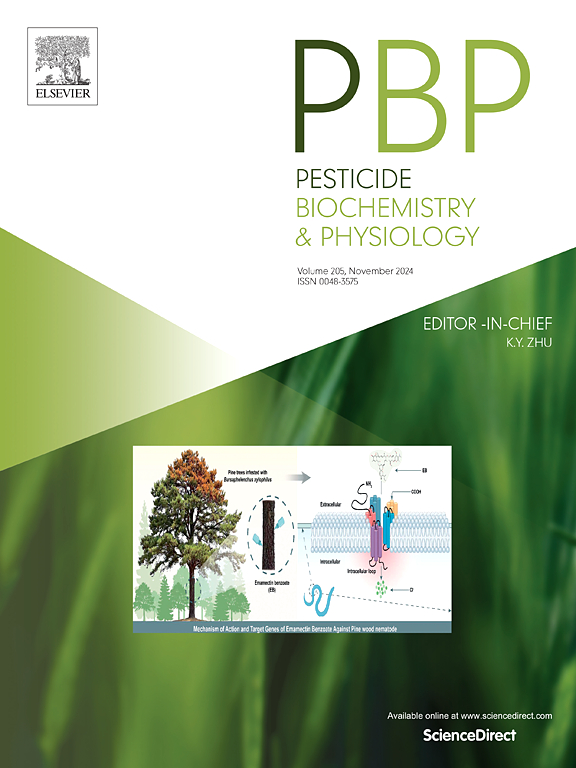Carrier solvent effects on the toxicity and penetration rate of fluralaner in the house fly, Musca domestica L. (Diptera: Muscidae)
IF 4.2
1区 农林科学
Q2 BIOCHEMISTRY & MOLECULAR BIOLOGY
引用次数: 0
Abstract
Penetration of an insecticide through the external insect cuticle is a critical determinant of spray contact efficacy and one of the many challenges in formulation efforts. Careful consideration of carrier solvent properties has been historically viewed as a way to improve penetration characteristics of insecticides through favorable physicochemical properties such as logP, but few studies exist on how modern carrier solvents impact cuticular penetration. Further, several models on cuticular penetration have been proposed in the past but few tests have ever been conducted to confirm them. The present study looked at how five commonly used solvents, butyl lactate, polar carbonate, propylene carbonate, and triethyl citrate, impact toxicological endpoints and penetration rates through the cuticles of house flies, a species often targeted with spray products. A two-compartment model of diffusion was also tested. The insecticide tested was the isoxazoline fluralaner, a chemical that has gained recent attention for potential in house fly control products. All solvents were found to have an antagonistic effect on mortality at 24 and 48 h in diagnostic dosing assays, with the exception of butyl lactate, which was statistically equivalent to acetone alone. LogP did not explain trends in mortality seen with any of the tested carrier solvents. Additionally, neither butyl lactate nor triethyl citrate altered penetration rates of fluralaner up to 8 h post treatment, compared to acetone. A simple two-compartment model similarly did not sufficiently explain penetration rates of fluralaner, belying first-order rate kinetics as a model for this process.

载体溶剂对氟氰烷对家蝇毒力及渗透率的影响(双翅目:蝇科)
杀虫剂通过昆虫外部角质层的渗透是喷雾接触效果的关键决定因素,也是配方工作中的许多挑战之一。仔细考虑载体溶剂的性质历来被认为是通过有利的物化性质(如logP)来改善杀虫剂渗透特性的一种方法,但关于现代载体溶剂如何影响表皮渗透的研究很少。此外,过去已经提出了几个关于表皮渗透的模型,但很少进行测试来证实它们。本研究考察了五种常用溶剂——乳酸丁酯、极性碳酸盐、碳酸丙烯酯和柠檬酸三乙酯——如何影响家蝇的毒理学终点和通过角质层的渗透率,家蝇通常是喷雾产品的目标物种。两室扩散模型也进行了测试。测试的杀虫剂是异恶唑啉氟拉烷,这种化学物质最近因在家蝇控制产品中具有潜力而受到关注。在诊断剂量测定中,所有溶剂都对24和48小时的死亡率有拮抗作用,但乳酸丁酯除外,其统计上与单独使用丙酮相当。LogP不能解释任何被测试的载体溶剂的死亡率趋势。此外,与丙酮相比,在处理后8小时内,乳酸丁酯和柠檬酸三乙酯都不会改变氟拉烷的渗透率。一个简单的双室模型同样不能充分解释氟拉烷的渗透速率,掩盖了一级速率动力学作为这一过程的模型。
本文章由计算机程序翻译,如有差异,请以英文原文为准。
求助全文
约1分钟内获得全文
求助全文
来源期刊
CiteScore
7.00
自引率
8.50%
发文量
238
审稿时长
4.2 months
期刊介绍:
Pesticide Biochemistry and Physiology publishes original scientific articles pertaining to the mode of action of plant protection agents such as insecticides, fungicides, herbicides, and similar compounds, including nonlethal pest control agents, biosynthesis of pheromones, hormones, and plant resistance agents. Manuscripts may include a biochemical, physiological, or molecular study for an understanding of comparative toxicology or selective toxicity of both target and nontarget organisms. Particular interest will be given to studies on the molecular biology of pest control, toxicology, and pesticide resistance.
Research Areas Emphasized Include the Biochemistry and Physiology of:
• Comparative toxicity
• Mode of action
• Pathophysiology
• Plant growth regulators
• Resistance
• Other effects of pesticides on both parasites and hosts.

 求助内容:
求助内容: 应助结果提醒方式:
应助结果提醒方式:


